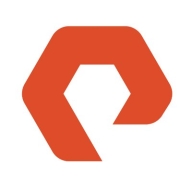


Find out in this report how the two File and Object Storage solutions compare in terms of features, pricing, service and support, easy of deployment, and ROI.
It does not require much management once you set up correctly, so it saves time, allowing an admin to focus on other work.
Since they operate 24 by seven, the necessary tasks are completed continuously, which is quicker than if my team handled them only between nine to five.
We had HPE hardware on Hyper-V previously, and HPE GreenLake gave us dHCI with VMware and a lot more stability.
I have seen a return on investment with HPE GreenLake for File Storage.
For me, the biggest return on investment when using this solution is that we do not have to have much support staff to run it.
The scalability challenge with previous systems is lessened with Nutanix since we can expand by adding new hardware without needing migrations.
We are saving approximately 20% to 25% compared with the competition.
I would rate them an eight out of ten.
The support is done through email and is not that great, making it a very problematic area I've been dealing with for over four years.
The reason for this rating is that there is no downtime.
On a scale from one being the worst and ten being the best, I rate my customer service and technical support for the HPE GreenLake for File Storage as a ten.
The support with GreenLake is good because we always have an engineer who helps the customer.
They come on the call, start troubleshooting immediately, and resolve issues effectively.
They are very knowledgeable, and if they can't solve the problem, they find the answer within a day or so.
I would give the customer service and technical support a ten out of ten.
Pure Storage FlashBlade is scalable.
It's suitable for startup growth as well as large enterprises, and the modular, disaggregated nature provides the flexibility needed for efficient application scaling.
Currently, we don't use any sort of scaling ability, but being able to buy what you need when you need it and only having to pay as you grow is a game changer for our operational costs; it's a money saver.
You can connect around 2 million storage servers to the same architecture, so scaling is not a problem.
This means you don't have to buy everything upfront; you can buy what you need and add more as you grow, which is advantageous.
These three components utilize scalability tools, enabling storage addition to nodes and supporting independent, linear performance growth.
I find the scalability of Nutanix Unified Storage (NUS) to be excellent, and I would rate it a ten based on my clients' requirements.
In case there is any issue with any blade, the data is moved to another.
The file system is very stable and it rarely goes down.
Having had zero catastrophic outages.
Since we've been on HPE GreenLake for File Storage, I have not experienced any downtime, crashes, or performance issues.
We have not experienced these issues with Nutanix, which I attribute to the all-flash technology, the quality of their platform, and the responsiveness of the hyper-converged infrastructure.
Nutanix Unified Storage (NUS) is very stable.
It automatically triggers tasks, causing performance issues.
Technical support definitely needs significant improvement.
Its configuration should be easier.
HP has already deployed AI in GreenLake's cloud features, but they should also integrate them into the flash array.
It provides a fast head start, but when dealing with complex situations, it doesn't lead you effectively.
If they could provide me with a troubleshooting document for the issue I was experiencing with connecting to Aruba Central, that would be great.
The main concern is pricing, which could deter some customers; addressing this would enhance its appeal.
The system should move towards AI-driven optimization and enhance S3 object storage capabilities.
System downtime can disturb the entire ecosystem and impact all applications.
The pricing of Pure Storage FlashBlade is expensive compared to other products I used from other companies in the past, but one benefit is that they have built-in ransomware protection.
It provides excellent pricing for massive enterprise customers wishing to remain on-premises while achieving competitive prices to cloud providers without requiring migration.
In summary, it's a predictable cost, but the VMware aspect is a problem.
HPE GreenLake for File Storage is relatively cheaper than Cisco, so that's a big plus.
Compared to buying three or four vendor solutions, it is much cheaper.
The cost has doubled for the same amount of data, which was a challenge when presenting use case justifications for the increased cost.
Nutanix Unified Storage (NUS) has definitely helped reduce our total cost of ownership.
We can plug in many blades, and we can have data up to one terabyte.
The best features of Pure Storage FlashBlade include better throughput and better performance.
This provides the flexibility of a pay-per-consumption model, allowing me to choose resources without investing in the entire platform.
It's important for my business that the solution has independent scaling of performance and capacity while our storage system is online.
I evaluate the solution's performance for eliminating front-end caching and data movement between media as fast; we don't notice any latency.
Nutanix Unified Storage (NUS) is appreciated for its fault tolerance and redundancy at the cluster level, which ensures reliable storage of files, folders, and other information accessible on the client side.
The cybersecurity features of Nutanix Unified Storage (NUS) when dealing with unstructured data, such as ransomware threats, provide the ability to detect and back up block-based storage, allowing me to restore repositories or sets of block storage with one button click, which is automatic.
My experience with using Nutanix Unified Storage (NUS) for data-intensive workloads is that we have many SQL Servers and they perform much better than they did when we used hybrid converged previously.
| Product | Market Share (%) |
|---|---|
| Nutanix Unified Storage (NUS) | 3.0% |
| HPE GreenLake for File Storage | 0.4% |
| Pure Storage FlashBlade | 5.7% |
| Other | 90.9% |



| Company Size | Count |
|---|---|
| Small Business | 11 |
| Midsize Enterprise | 11 |
| Large Enterprise | 20 |
| Company Size | Count |
|---|---|
| Small Business | 2 |
| Midsize Enterprise | 2 |
| Large Enterprise | 14 |
| Company Size | Count |
|---|---|
| Small Business | 27 |
| Midsize Enterprise | 30 |
| Large Enterprise | 63 |
FlashBlade is the industry’s most advanced scale-out storage for unstructured data, powered by a modern, massively parallel architecture to consolidate complex data silos (like backup appliances and data lakes) and accelerate tomorrow’s discoveries and insights.
HPE GreenLake for File Storage offers flexible, scalable storage solutions, catering to enterprise needs with on-premises services and a cloud-like experience. It aims to simplify data management while providing operational agility.
HPE GreenLake for File Storage empowers organizations with an on-premises cloud service model, offering a consumption-based approach that aligns costs with demand. It supports various workloads through quick deployment and efficient capacity management, making it suitable for enterprises seeking flexible data storage solutions. Businesses benefit from streamlined operations with a focus on optimizing performance and security.
What are the key features of HPE GreenLake for File Storage?In financial services and healthcare sectors, HPE GreenLake for File Storage is implemented to manage large volumes of sensitive data. Its scalability and security features provide valuable support for compliance and data protection, while the consumption-based model ensures cost control and flexibility in data handling.
Nutanix Unified Storage provides high availability and seamless cloud platform integration, ensuring robust redundancy, scalability, and streamlined management. It supports hybrid cloud connectivity, enhancing storage security and performance.
Nutanix Unified Storage is designed for effective data protection across block, file, and object storage, offering features like ransomware detection and a centralized management interface through Prism Central. Users gain improved SLAs and IT cost savings through its efficient performance. Despite its user-friendly interface, there is a demand for enhanced security measures such as Multi-Factor Authentication and DLP. While its resilience is notable, users seek improvements in protocol compatibility, storage capabilities, pricing, and support processes.
What are the most important features of Nutanix Unified Storage?Industries implement Nutanix Unified Storage for tasks such as file storage, database performance improvement, and storage solution consolidation. Companies deploying virtual machines, securing against ransomware, connecting hybrid clouds, and backing up data find it useful. It supports workloads like Citrix VDI, Kubernetes, and research data, assisting many organizations migrating from legacy storage for better cost efficiency and reduced data center footprints.
We monitor all File and Object Storage reviews to prevent fraudulent reviews and keep review quality high. We do not post reviews by company employees or direct competitors. We validate each review for authenticity via cross-reference with LinkedIn, and personal follow-up with the reviewer when necessary.